2015 Annual Report for LNC12-347
Increasing Varietal Suitability and Availability of Cowpea and Forage Radish Cover Crop Seed for Northern Climates
Summary
We continued radish work via an on-farm seed increase, public outreach, and an initial evaluation of our intended method for rapid radish breeding in the upper Midwest. We completed the third year of cowpea variety trials, shared the results with the public, and selected cowpea varieties are being prepared for further increase and commercialization.
Objectives/Performance Targets
- Increase seed of six cowpea accessions and two control varieties in Puerto Rico.
- Increase seed of our new radish population in North Dakota.
- Carry out replicated evaluations of our remaining six cowpea accessions and controls across the upper Midwest.
- Conduct field days and workshops to keep NPSAS members and the public aware of our progress and the importance of cover crops.
- Identify cowpea accessions worthy of further seed increase and public use.
Accomplishments/Milestones
In early January of 2015 cowpea seed was sent to Bryan Brunner at the University of Puerto Rico research station in Lajas for increase. We sent six accessions identified from our results in 2014 as being especially promising (PI 293499, PI 293525, PI 293570, PI 352903, PI 493446, and PI 493468) and two commercial controls (Iron and Clay, Red Ripper). The growing season in the winter of 2014-2015 was very wet and the seed was planted late. It was also later to mature and to receive back in North Dakota, so seed was shipped to collaborators in North Dakota (Pat Carr, Steve Zwinger, Hans Kandel), South Dakota (Peter Sexton), Minnesota (Tom Michaels), and Wisconsin (Erin Silva) in late May. Remaining seed was sent to a locker storage in Fargo for a few months of freezing to kill any Cowpea Weevils that may have infested the seeds so that they could be stored safely until the 2016 growing season.
Our supply of radish seeds was not very large after the wet year that our partner in Wisconsin, Katrina Becker, had experienced in 2014. However, an NPSAS member, Owen Trangsrud, planted most of the two pounds of seed on his farm near Enderlin, ND as early as he could in spring. This has worked to vernalize and promote flowering in radish in all of our experimental plantings in North Dakota and Wisconsin, and it was again successful.
Our university partners managed their cowpea plots (3-5 replicates at each location) and gathered data on vigor, cover, flowering, and more. Unfortunately the plots in Carrington, ND were damaged by hail and were terminated in mid summer. Plots at the other sites were harvested for seed yield and/or for biomass in September.
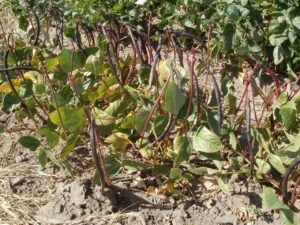
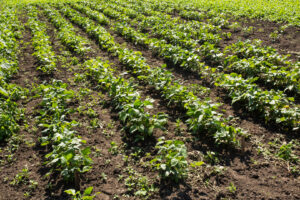
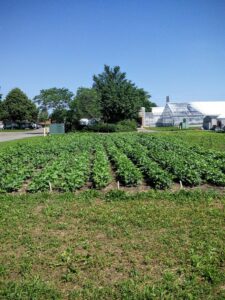
Cowpeas growing at Dickinson, ND, Arlington, WI, and St Paul, MN in 2015.
At most sites we were able to get video clips of each cowpea variety to show to farmers later in the fall and the winter, and the plots were featured during field days at each site on various days in July, August, and September. We also held a field day at the Trangsrud farm in late July that featured the radishes and several other NPSAS seed projects. Participatory ratings of the cowpeas were collected in Dickinson and Prosper, ND, although the number of participants was low (2 and 3 respectively). These videos and/or our data have been presented to the public during workshops held at the Minnesota Organic Conference, the NPSAS Winter Conference, the ND Local Foods Conference, and at the NPSAS Farm Breeding Club Winter Meeting. We are posting these also to our YouTube channel and hoping to get additional input from farmers in the region as to which cowpeas are their favorites. Project updates have also been made via the NPSAS Germinator newsletter, our eSprout notices, and our FBC Facebook page.
With the very late fall, we were unexpectedly able to continue our radish work in November. There were a large number of volunteer radish roots that established after the seed harvest in August. As these started growing at about the time most late cover crops are planted, we were able to inspect the roots and evaluate the diversity of the new population and the ability of the plants to grow big roots quickly while not bolting too early. We shot some video and put this up on YouTube to explain the project and why we want to breed better radish varieties for cover crop use.
Harvested radish roots were sent to Hugh Dufner’s potato storage facility to see if we could successfully store these somewhat immature roots long enough to plant them out for intermating and seed increase in the spring. Owen also mulched some of the remaining volunteer plants to see if that would be enough to safely overwinter the roots in place. If either technique is successful, we could plant radishes in August like farmers normally do, select rapidly growing roots of the sort most likely to benefit soil conditions, and then intermate these the following spring to form an improved generation of this population. Recurrent mass selection of this sort is expected to rapidly improve the population for cover crop purposes in the upper Midwest (selection and recombination in two summers). This would also be much easier to do on farm than the more indirect but proven technique of growing some roots from early July plantings to full maturity, saving them over winter, planting them out for intermating the following spring, harvesting seeds for planting out in half sib family rows (one for each plant) late that summer, evaluating the rows for cover crop performance, and then planting out remnant seeds of the best performing families the following spring to generate the improved population (a three summer process).
Impacts and Contributions/Outcomes
The increase of radish seed resulted in about 10 pounds of seed for further increase and selection in 2016. As of late winter 2016 the roots were still holding in storage and mulched roots in the field appeared healthy, although it was a very warm winter and this might not always work out so well. Our video of the radish selections was shown at the NPSAS Winter Conference and has received 68 views on YouTube.
Cowpea data was collected together and average performance determined from site averages from across three years of evaluation (11 site years, 2016 Cowpea Data Summary). These results were shown to audiences in Minnesota and North Dakota, and were the basis of variety selections during the Farm Breeding Club Member Meeting in Medina, ND in February, 2016. Our videos of the cowpea trials are not all posted yet, but interest in rating varieties via video has not worked as hoped so far, with only a dozen or two views of posted videos and few reports back. Unfortunately, farmers are frequently not able to get to field days to actively participate in variety evaluation, and are not always confident in their variety assessments using data tables and video clips either. We are currently pulling together all of the plot data from all of our collaborators in order to do a full statistical analysis of yield and cover crop potential for these varieties, with the aim of publishing a note on cowpea variety trials in the region.
NPSAS is discussing with PulseUSA, a seed grower cooperative, the possibility of having this experienced group further increase the seeds of at least three cowpea varieties for commercialization by 2018. We have about 70-100 pounds of each variety on hand, enough to plant a few acres to get the process underway. Given recent results in the variety trials, this could potentially increase seed supplies of each variety up to 2000 or more pounds in 2016.
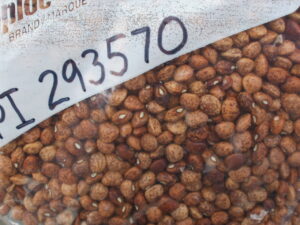
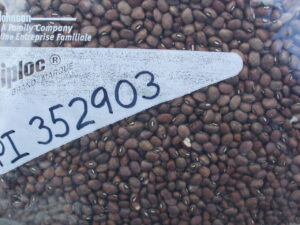
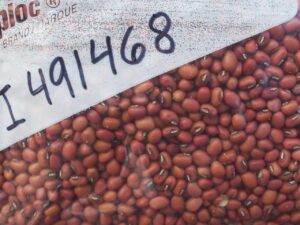
Cowpeas being considered for further increase and cover crop use.
Collaborators:
farmers
Stoney Acres Farm
7002 Rangeline RD
Athens, WI 54411
Office Phone: 7154324683
Agronomist/Associate Professor
South Dakota State University
Box 2207A
Brookings, SD 57007
Office Phone: 6056886179
Associate Scientist, Organic Production Specialist
University of Wisconsin- Madison
1575 Linden Drive
Madison , WI 53706
Office Phone: 6088901503
Agronomist/Adjunct Professor
Dickinson Research Extension center
1041 State Avenue
Dickinson, ND 58601
Office Phone: 7014832348
NRCS District Conservationist
Burleigh County Soil COnservation District
916 East Interstate Ave Suite 6
Bismarck , ND 58503
Office Phone: 7012504518